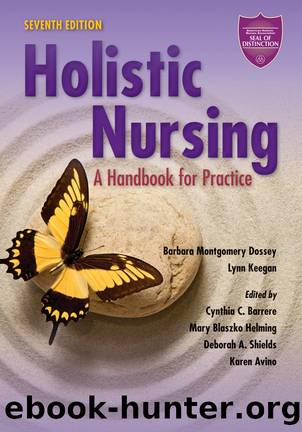Holistic Nursing by Dossey Barbara Montgomery Keegan Lynn Barrere Cynthia

Author:Dossey, Barbara Montgomery,Keegan, Lynn,Barrere, Cynthia
Language: eng
Format: epub
Publisher: Jones & Bartlett Learning LLC
Published: 2015-08-15T00:00:00+00:00
Distinguishing Characteristics of a Holistic Orientation to Communication
Preaccess and Assessment Phase
The holistic communication process acknowledges the importance of being centered and creating an intention before engaging in a caring, healing interaction with another. These two processes, being centered and creating intention, constitute the preaccess phase involved in holistic interactions. This phase lays the foundation for caring, healing communication and occurs before any person-to-person interaction takes place. As the nurse stays present to the moment, to self, and to the person, a healing environment is maintained. Consciously creating a healing environment, no matter where one is working, nurtures both the client and the self at a deep level.2, p. 623
It is useful to note the distinction between accessing and assessment. The term accessing is preferred because it has the connotation of being open to receiving information in a nonjudgmental way. The term assessment implies appraising, evaluating, and judging. An essential characteristic of holistic communication is the mutuality inherent in the experience—this means that both the nurse and the client participate equally in the process. Utilizing language that supports the concept of partnership reinforces a commitment to mutuality.
Acknowledgment of the Infinite and Sacred Nature of Being
Holistic nursing acknowledges that people are infinite, sacred, and spiritual beings. Florence Nightingale spoke of human beings as a “reflection of the Divine with physical, metaphysical, and intellectual attributes.” Jean Watson teaches that we are “sacred beings,” and Martha Rogers speaks of unitary human beings as “energy fields that are infinite in nature.” The Model of Whole-Person Caring combines these concepts to define person as “an energy field that is open, infinite, and spiritual in essence and in continual mutual process with the environment. Each person manifests unique physical, mental, emotional, and social or relational patterns that are interrelated, inseparable, and continually evolving.”3, p. 42 Thus, from the perspective of holistic nursing theorists and models, people are infinite and sacred in nature. This orientation makes a difference in how we approach one another. It shifts how we speak, listen, relate, and interact. When we perceive human beings as sacred, our words, actions, and behaviors are significantly affected.
Moreover, when we view ourselves and others as spiritual, infinite beings with finite bodies, our relationship to illness, disease, and death shifts dramatically. Communication may be oriented to the soul’s purpose in addition to symptom relief. This orientation creates a potential to explore and derive meaning from life’s challenges and create a healing environment even in the face of death and terminal illness. Nurses who care for patients with terminal illnesses often are uncomfortable discussing prognosis, hospice care, advanced care planning, and spirituality.10
When one understands that this physical life is a small part of the infinite journey, the stigma of death becomes obsolete and allows the nurse to be fully present to persons with terminal illnesses and facing imminent death.
Heart-Centering, Heart Coherence, and the Intuitive Heart
Heart-centering is one of the first processes the nurse engages in prior to any interaction. This process involves the nurse focusing her or his attention on the heart, setting aside concerns and thoughts, and connecting with feelings of love and compassion.
Download
This site does not store any files on its server. We only index and link to content provided by other sites. Please contact the content providers to delete copyright contents if any and email us, we'll remove relevant links or contents immediately.
| Administration & Medicine Economics | Allied Health Professions |
| Basic Sciences | Dentistry |
| History | Medical Informatics |
| Medicine | Nursing |
| Pharmacology | Psychology |
| Research | Veterinary Medicine |
1610396766 (N) by Jo Ann Jenkins(1628)
Elizabeth Is Missing by Emma Healey(1620)
Economics and Financial Management for Nurses and Nurse Leaders, Third Edition by Susan J. Penner RN MN MPA DrPH CNL(1487)
McGraw-Hill Nurses Drug Handbook by Patricia Schull(1466)
Cherry Ames Boxed Set, Books 1 - 4 by Helen Wells(1394)
Home. by Sarah Graham(1374)
NCLEX-RN Prep Plus 2019 by Kaplan Nursing(1358)
The Language of Kindness by Christie Watson(1346)
Cherry Ames, Student Nurse by Helen Wells(1337)
Spiritual Midwifery by Ina May Gaskin(1334)
Cherry Ames Boxed Set, Books 5 - 8 by Helen Wells(1307)
Whoever Tells the Best Story Wins: How to Use Your Own Stories to Communicate with Power and Impact by Annette Simmons(1272)
Cracking the Nursing Interview by Jim Keogh(1254)
1476763445 by Liz Fenton(1231)
Getting Started with Arduino by Massimo Banzi(1187)
Dementia by June Andrews(1178)
Children's Medicines by Edward A. Bell(1142)
Cherry Ames, Army Nurse by Helen Wells(1124)
Need you Now (Top Shelf Romance Book 2) by unknow(1116)
